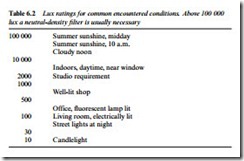COLOUR TEMPERATURE COMPENSATION
White light has two basic specifications, its luminance or brightness (measured for TV-camera purposes in lux) which corresponds to the level of the Y signal; and its colour temperature, which describes the ‘shade’ of white, in practice between the predominantly-red light from tungsten filament bulbs and the bluish light scattered from a cloudy sky. Colour temperature is expressed in terms of degrees Kelvin (°K), corresponding to the temperature to which a black object (i.e. a carbon block) must be raised to emit a similar white. Tungsten lighting has a characteristic colour temperature of 3200°K, and the electrical circuits of the camera are generally optimised to give true white (zero chroma signals) at this point.
Our eyes and brain can compensate for differing colour temperatures in the scenes we view, so flesh tones and white objects do not appear to change in hue whether viewed by electric or natural light. A TV camera does not have this inherent correction, so to maintain white balance under all lighting circumstances correction must be made. The simplest cameras have a ‘daylight’ lever on the lens assembly which flips a yellow-orange conversion filter into the optical path to bring daylight (average 6500°K) to the standard 3200°K point for the camera. An alternative method is to switch the gains of the R and B amplifiers between preset points by means of a three position switch mounted on the back of the camera, offering tungsten/cloudy/sunny settings – colour temperature and lux ratings for familiar situations are given in Tables 6.1 and 6.2.
A sample of white at whatever colour temperature is present on site can be obtained by fitting a white translucent lens cap or by pointing the camera at a white surface. For a true white output signal from the camera, both colour-difference signals R−Y and B−Y must be zero; alternatively, and amounting to the same thing: R = G = B. In
![]() cameras equipped with auto-white balance, pressing the set-white but- ton starts an automatic process of gain adjustment in the R and B amplifier channels to achieve this status.
cameras equipped with auto-white balance, pressing the set-white but- ton starts an automatic process of gain adjustment in the R and B amplifier channels to achieve this status.
The required offset voltage is noted by a microprocessor system which puts into store a number representing the plus or minus gain characteristic for each of R and B compared with the normal (i.e. 3200°K) setting. The stored numbers are subsequently allowed to control R and B gain via a D to A (Digital to Analogue) converter and an IC-based voltage-controlled attenuator. The achievement of correct white balance is signalled by an LED indicator or an electronic symbol on the viewfinder screen. All pictures produced by the camera will now conform to the preset white point, and such subtle tints as flesh tones and eye colours will be faithfully reproduced.

